It was already back to school last week… But for those who braved the traffic last Thursday, it was also the opportunity to participate in our last Café, croissants, Marketo, on the theme of “Content Marketing”.
A Café, croissants at our friends from Cedexis (thanks again to Céline Foubert!), in the presence of Guilhem Bertholet, founder of Invox.
B2B marketing: a state of the art
The tremendous development of “MarTech” technologies over the last ten years has generated a lot of hope in the ability to better reach its audience, the promise of a message at the right time, to the right person, with the right content.
Let’s be honest, we sometimes notice among our clients, mostly SMEs and key accounts, a bit of exhaustion, the feeling of having done a lot of things, but not always reaping all the benefits.
Guilhem explains to us that from now on, we must resolutely situate ourselves in a “Demand Generation” strategy (Arrrggh, another English acronym!). To do this, let’s take a look at what we can still see all too frequently today:
1/ It is no longer enough to create content and make it visible to “create the buzz”, it worked at the beginning, but today – almost – everyone produces content and the attention of Internet users is limited. The risk is to “generate noise”, to get exhausted, but to have no conversion behind.
2/ Similarly, a focus on sending the newsletter of the month, its opening rate, its click rate will very quickly find its limit. What story are you telling? Does your newsletter really add value to the reader or is it still very self-centered?
3/ Generally speaking, pushing self-centered content (offers, customer testimonials…) from the very first contacts is a good way to lose your visitors. As in any human relationship, you must first capture the attention of your prospect, by putting yourself in his shoes.
My personal development coach François Boizot explained it to me one day:
It’s the same in the digital world: you have to go looking for your interlocutors, where they are, in their thoughts, and not believe that they are waiting for your offer, hanging on your blog.
4/ One of the difficulties is to know where your interlocutor is in his journey with you: has he just arrived? Has he already downloaded your recorded webinar? Have they spoken to a sales person? Without marketing automation to listen to all these interactions and score them, it is impossible to automate the sending of the right content at the right time.
5/ Finally, one of the most common causes of failure is the lack of alignment between marketing and sales.
A lot of effort on both sides can be wasted without this famous Alignment. But what are we talking about? We are talking about designing customer journeys together, setting up joint scoring, working together on approach strategies combining content, automation and sales actions… Both departments need to work together to generate revenue, and they need to agree on how to do it (we’ll talk about this at the end of the article).
Content is coming of age! On the way to the “Demand Generation
The strategy of attracting prospects to you digitally is relatively new in the context of marketing in general, and the practice has already evolved considerably. The situations described above are often the result of not having continued to “follow the wave”, of not having evolved with the practice. Guilhem explains that we have gone through these different phases in a few years (careful, I’m caricaturing):
- I make content: it was “the good times”, I produce content, I put it on my blog, I amplify on my social network and I see my traffic climbing by 10% every month! That was cool! My main KPI is my audience.
- I’m doing “Content Marketing“: the audience is good, but I have to produce leads; I had forgotten that there were sales behind it. My KPI becomes the Marketing Qualified Lead (MQL), i.e. a serious lead that I can present to Sales (I have qualified the lead a little, removed the competitors, the job seekers, the tests…)
- I do “Marketing Automation“: well Sales are not happy with all the leads I send them, they tell me they are not ready to be called! No problem, I set up scoring and an automated lead path (to make it progress with the score), and I only send the hot leads. My KPI becomes Sales Qualified Lead (SQL), which means that qualification is much more important: hot lead, thanks to scoring, or even BANT (budget – decision maker – need – timeline information)
- I have a “Demand Generation” strategy: I have done everything right on the marketing automation side but the results are not there or not there enough… I am asked to take care of the “pipeline” and the revenue. But what is expected of me? Let’s find out the whole thing below 😉
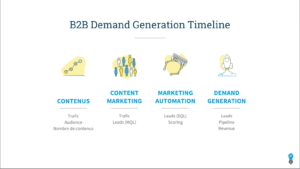
B2B generation timeline
The “Demand Generation” Strategy
This strategy requires implementing improvements in each of the marketing compartments, so it is for relatively mature teams (who have gone through the first three steps above).
Content: less but better
It is no longer a question of producing the most content to be the most visible, but to have the most relevant content, of the best quality at each stage of your customer journey, and by privileging the diversity of formats:
- blog, infographics, snack content, SEO content to attract attention and drive traffic to your sites,
- white papers, newsletters, quizzes, webinars to generate leads and start qualification
- trainings, webinars, blogs, newsletter, facebook live to nurture, continue to discuss with your prospect to refine his profile, his preferences,
- case studies, advanced webinars, cheat cheets to push towards the sale
- sprinkle questionnaires, tests, verticalized content, product-related information, to finish scoring, qualifying and recovering data that is very useful for sales in the next step
- snack content, advocacy, curation to win the social media battle
The big risk in content is to produce it – which is quite exhausting in terms of resources – and that it doesn’t deliver value (I know, I experienced it in my early years of marketing ;-). In order to move into an industrial logic, you will turn to these tools:
- The buyer persona, which describes on an A4 who you are talking to: very useful to frame the “tone of voice”, and educate internally on who your customers are
- The customer journey (“lead cycle”), which describes the sequence of actions from the moment a lead is interested in you, to the closing of the deal, then the recycle, the cross sell or the upsell. Examining this process often allows you to identify shortcomings in the organization, processes or content, and to put yourself in a logic of quick wins (“quick win”)
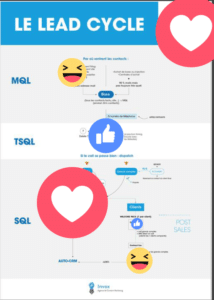
lead life cycle
- Content Mapping allows you to map out, by buyer persona, how content should be linked together in order to respond to your prospects’ problems throughout their customer journey. This matrix – very visual – makes you aware of the moments in the customer journey that are “orphaned” in terms of content, and those on which you may have over-invested

content mapping
- The editorial book to know exactly who you are talking to. Do you adopt a serious tone with a given buyer persona? Offbeat? Funny?
- The distribution plan that allows you to calibrate the amplification of content on the different channels
The mechanics of production
You will only be able to meet production objectives in terms of both quality and quantity if your content production process is industrialized.
Trying to get into a “Demand Generation” strategy by relying on resources already present to do operational marketing, or interns – I have nothing against interns 😉 – is a sure recipe for failure.
Delivering quality content on a regular basis requires having resources whose responsibility it is, who are trained for it, who have the right personality and who have the bandwidth to do the various tasks:
- Generate the idea
- Write the brief
- Make the visual brief, or even the moodboard if it’s visual content
- Have the idea validated
- Create the content
- Validation back and forth
- Pre-proofread
- Re- Validation back and forth
- Icono and/or Design
- Proofread
- Integration
- SEO optimization
- Publication
- Distribution and optimization, in a cycle of continuous improvement
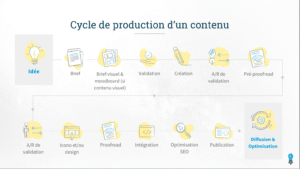
content production cycle
In short, all the industrialization efforts you have already made on the Marketing Automation side must be replicated with the same quality on the Content side.
Content, an infinitely stretchable gold bar
You’re going to tell me: “but how can we make less content, but better”, but at the same time, manage to make content for all the buyer personas and at each moment of the customer journey?
The idea is to make an effort to speak out, with convictions on a given subject, and to use different media and formats to do so.
For example: your white paper can be cut into blog articles, which are themselves adapted into “snack content”, then reworked to make a webinar, which we will record, then turn into short videos of 1 to 2 minutes, and so on.
So you make a big effort of creativity once and you decline it endlessly.
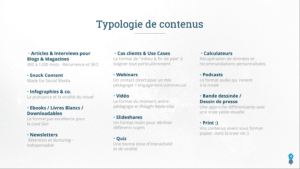
content typology
Combine Inbound and Outbound
Guilhem explains that we should not be dogmatic. There was a time when priority was given to outbound marketing strategies; today, we need to mix outbound and inbound strategies, both of which rely on quality content.
Indeed, the results of the two strategies are very different over time:
- An inbound marketing strategy will produce results over time, exponentially if successful. The results can be slow to come if you don’t find the right tone, the right subjects…
- An outbound marketing strategy will produce immediate results, but will run out of steam quite quickly as soon as you stop investing
You have to mix the two depending on your business objectives.
1 Euro in Content = 1 Euro in Visibility
As you can see, the mechanics of content production – on a certain scale – require a real organization, and means. It’s a shame to put all this in place and not think about amplifying it to the maximum via the social networks relevant to your brand and your message.
Guilhem’s recommendation is: if you spend one euro on content, spend another on amplification and visibility.
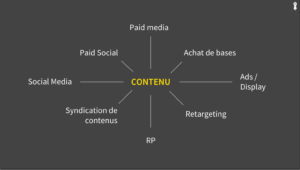
content amplification
Finally, involve the sales teams
One of the key points of a successful Demand Generation strategy is the alignment of Sales and Marketing.
What exactly does this mean?
It’s about getting your sales teams to welcome the leads generated by marketing. Getting there is often a real project within a project:
- Educating sales about what’s changing in marketing, and the promise that they’ll get fewer but better qualified leads
- Map out the customer journey from lead generation to deal closure, and then the renewal part. Share what works and what doesn’t.
- Involve them in the implementation of the scoring program and the lead life cycle in marketing automation
- Define common success KPIs
- Set up monthly, then weekly, meetings where marketing explains the campaigns that will be produced, where we review the KPIs (leads generated, leads converted or rejected, sales generated, average time to handle a lead…)
- … and if the magic happens, the sales people will become more and more interested in campaigns, will refine the buyer persona, enrich the customer journey, suggest content to produce, and see marketing as a partner
Victory!
Une montée en maturité progressive
All of this is implemented little by little in an organization and can sometimes take several months to produce results, which is always scary.
Another way is to delegate the implementation of this strategy to Merlin/Leonard thanks to our “Smart Inbound Marketing” offer, which produces results after only three months!
An all-inclusive offer, which allows you to benefit immediately from the best practices of Content Marketing and Marketing Automation, with a budget defined in advance. Ideal to start in ” Prototype ” mode and measure ” if it really works “, without having to set up all the internal mechanics – projects, recruitment, organizational changes…
We are of course at your disposal to discuss it!






